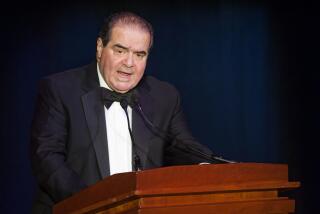Digging Into Obscenity Again
Thirty years ago, in the case of Roth vs. United States, the U.S. Supreme Court held that obscenity was not protected by the First Amendment guarantee of freedom of speech. Since then the court has returned time and again to the troubling question of what obscenity is after all, each time digging itself deeper into a philosophical and legal morass. This week it tackled the question again, with results that are no more enlightening, though they may make it harder for prosecutors to obtain a conviction for selling obscene material.
In 1973, in the case of Miller vs. California, the court established a three-part test for obscenity. In order to be judged obscene, the court said, a book, film or other work must meet all three parts: (1) its dominant theme, taken as a whole, must appeal to prurient interest; (2) it must depict sexual conduct in a patently offensive way, and (3) the work, taken as a whole, must lack “serious literary, artistic, political or scientific value.”
The question then became by what standard each of the three parts of the Miller test was to be judged. In Roth, Miller and subsequent cases, “contemporary community standards” appeared to be what the court had in mind, and that was the test applied to parts 1 and 2. But there was a question as to whether community standards could properly judge whether a work had serious value.
This week, in the case of Pope vs. Illinois (No. 85-1973), the court held 5 to 4 that community standards were not the right test for value. Instead, the justices said, a “reasonable person” test should be applied. That is, never mind what the community standards are. Would a reasonable person viewing this material think it lacked value? As a result, defendants in obscenity trials may call expert witnesses to testify about the value of a work, and the jury may take that testimony into account regardless of what the community standards are.
So obscenity convictions should be harder to obtain, which is all to the good. But it would have been even better if the minority view in this week’s case had prevailed. The dissenters--Justices John Paul Stevens, William J. Brennan Jr., Thurgood Marshall and Harry A. Blackmun--argued that the “reasonable person” test was subject to all the flaws that plagued the “community standards” test, and that juries could still find material obscene just because it offended them.
Stevens wrote that the four dissenting justices would declare unconstitutional all laws that “criminalize the sale of magazines to consenting adults who enjoy the constitutional right to read and possess them.”
This is the view of this matter that we prefer, and someday, perhaps, a fifth justice will see the light and make the minority opinion the majority view. In the meantime, we’ll have to settle for any decision that makes it harder to convict people for selling obscene material. Every adult should be free to read what he or she wants to.
More to Read
Sign up for our Book Club newsletter
Get the latest news, events and more from the Los Angeles Times Book Club, and help us get L.A. reading and talking.
You may occasionally receive promotional content from the Los Angeles Times.






